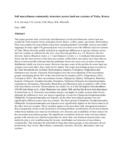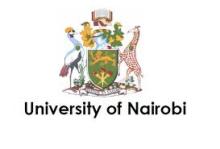Resource information
This paper presents data on diversity and abundance of soil macrofauna in various land use systems in Taita (natural forest, plantation forest, fallow, coffee, napier, and maize, Horticulture. Each was sampled for macrofauna using three sampling methods (monolith,
transect and pitfall trapping). Seventy eight (78) genera/species were recorded across the different land use systems of Taita. Rényi diversity profile indicated no significant differences in species richness across land use systems as reflected by the very close
diversity profiles at α = 0. However, the two diversity indices (Shannon index: α = 1 and Simpson’s index: α
= 2) indicated that plantation forest was the most diverse of the land use systems, while fallow and maize were least diverse. Rényi evenness profile indicated that the plantation forest was most even in terms of species distribution which was least in maize.
However because some of the profiles for some land use systems cross each other, they could not be ranked. The major macrofauna groups recorded in the Taita benchmark site included: Hymenoptera, Isoptera, Coleoptera, Oligochaeta and Orthoptera and Arenae.
Generally Hymenoptera were the most abundant of the macrofauna groups constituting about 36% of the total followed by Isoptera (22%), Oligochaeta (16%), Coleoptera (10%). The other macrofauna (Arenae, Diplopoda, Diptera, Orthoptera, Blattidae, Isopoda,
Chilopoda- Geopholomorpha, Hemiptera, Opiliones,Chiopoda-Scolopendromorpha, Lepidoptera, Dermaptera, Phasmidae, Blattelidae and Mantodea each constituted <10% of the total macrofauna recorded. Hymenoptera was ranked 1st as it had the highest total abundance (59,440 individuals m-2), while Mantodea was ranked 18th and had the lowest total abundance (6 individuals m-2). Generally macrofauna density was higher in arable systems than forests, although the differences were not always significant. Except for Chilopoda-Geopholomorpha, Chilopoda-
Scolopendromorpha and Isopoda, all the other macroafauna groups were not significantly different across land use systems. The three groups (Chilopoda- Geopholomorpha, Chilopoda- Scolopendromorpha and Isopoda) were significantly highest in the forests than
in all the other land use systems. These variation appear to be associated with management practices that consequently results in the destruction of nesting habitats, modification of soil microclimate within these habitats and removal of substrate, low diversity and availability of food sources for the associated macrofauna groups. The significant correlations between some soil macrofauna groups with selected soil chemical properties too show that, soil chemical characteristics may indirectly play a role in influencing the density, distribution and structure of macrofauna communities. This indicates the potential of using these fauna groups as bio-indicators of soil productivity.
Key words: Macrofauna; community structure; diversity; abundance; land use systems.


